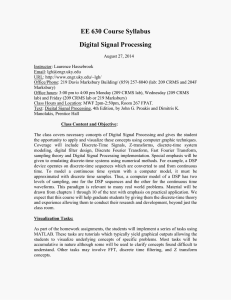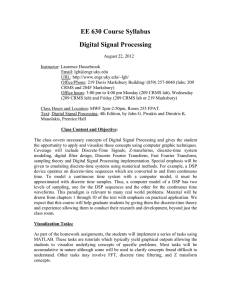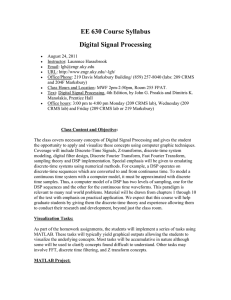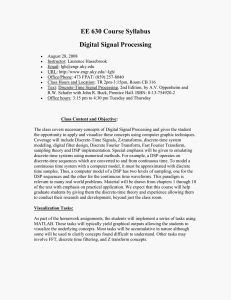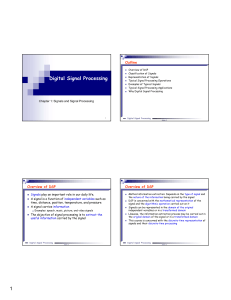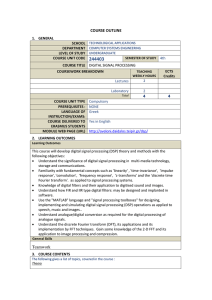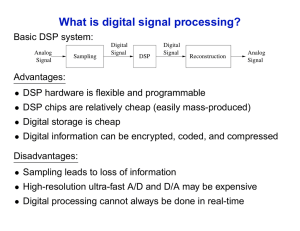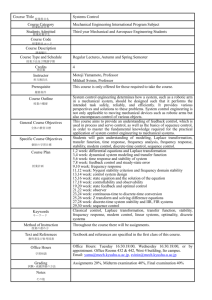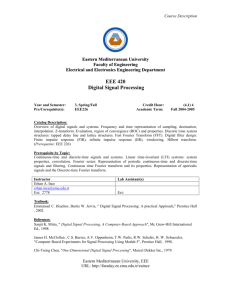EE 630 Course Syllabus Digital Signal Processing
advertisement
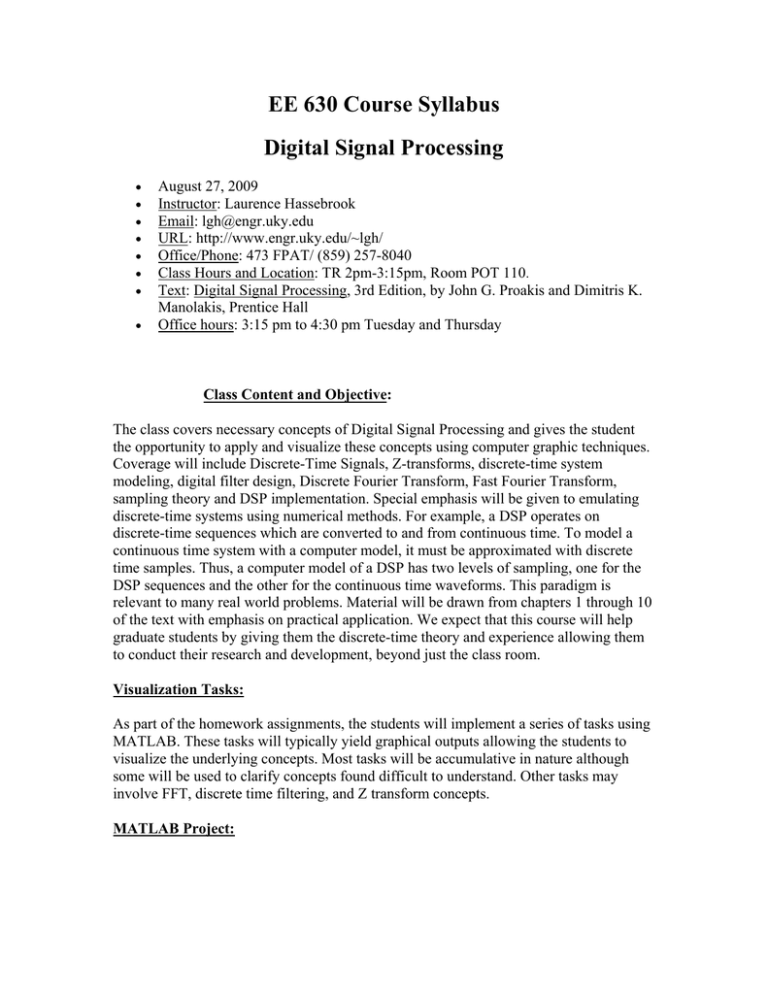
EE 630 Course Syllabus Digital Signal Processing • • • • • • • • August 27, 2009 Instructor: Laurence Hassebrook Email: lgh@engr.uky.edu URL: http://www.engr.uky.edu/~lgh/ Office/Phone: 473 FPAT/ (859) 257-8040 Class Hours and Location: TR 2pm-3:15pm, Room POT 110. Text: Digital Signal Processing, 3rd Edition, by John G. Proakis and Dimitris K. Manolakis, Prentice Hall Office hours: 3:15 pm to 4:30 pm Tuesday and Thursday Class Content and Objective: The class covers necessary concepts of Digital Signal Processing and gives the student the opportunity to apply and visualize these concepts using computer graphic techniques. Coverage will include Discrete-Time Signals, Z-transforms, discrete-time system modeling, digital filter design, Discrete Fourier Transform, Fast Fourier Transform, sampling theory and DSP implementation. Special emphasis will be given to emulating discrete-time systems using numerical methods. For example, a DSP operates on discrete-time sequences which are converted to and from continuous time. To model a continuous time system with a computer model, it must be approximated with discrete time samples. Thus, a computer model of a DSP has two levels of sampling, one for the DSP sequences and the other for the continuous time waveforms. This paradigm is relevant to many real world problems. Material will be drawn from chapters 1 through 10 of the text with emphasis on practical application. We expect that this course will help graduate students by giving them the discrete-time theory and experience allowing them to conduct their research and development, beyond just the class room. Visualization Tasks: As part of the homework assignments, the students will implement a series of tasks using MATLAB. These tasks will typically yield graphical outputs allowing the students to visualize the underlying concepts. Most tasks will be accumulative in nature although some will be used to clarify concepts found difficult to understand. Other tasks may involve FFT, discrete time filtering, and Z transform concepts. MATLAB Project: MATLAB project will consist of real data. Student will use DSP techniques to analyze data and construct a calibrated simulation of the data. More information will be provided as semester passes. Grading Policy: • • • • Homework: 25%: Once a week, Due one week after assignment, No late homework, drop the lowest 1. At most, one visualization task per homework. MATLAB Projects: 25%: teams will be limited to 2 people per team. Exam 1: 25% (Date to be announced, closed book, 1 page crib sheet). Exam 2: 25% (Date to be announced, open book). Reference: 1. Text: Digital Signal Processing, A Computer-Based Approach, 3nd Edition, by Sanjit K. Mitra, McGraw Hill. 2. Digital Signal Processing, Principles, Algorithms, and Applications, 3rd Edition by John G. Proakis and Dimitris G. Manolakis, Prentice Hall Inc., 1996. 3. Digital Signal Processing, 1nd Edition, by A.V. Oppenheim and R.W. Schafer, Prentice Hall. 4. Discrete-Time Signal Processing, 2nd Edition, by A.V. Oppenheim and R.W. Schafer with John R. Buck, Prentice Hall. 5. Digital and Analog Communication Systems by Leon W. Couch, Fourth Edition. 6. Principles of Communications, Systems, Modulation, and Noise by R, E. Ziemer and W. H. Tranter, Third Edition. 7. Introduction to Fourier Optics by J. W. Goodman, McGraw Hill. 8. Digital Communication by E. A. Lee and D. G. Messerschmitt. 9. Digital Transmission of Information by R. E. Blahut. 10. Introductory Probability and Statistical Applications by P. L. Meyer. 11. Probability and Statistics by M. H. DeGroot. 12. Digital Communication Systems by Simon Haykin. 13. An Introduction to Analog & Digital Communications by Simon Haykin. 14. Communication Systems by Simon Haykin, Second Edition.
